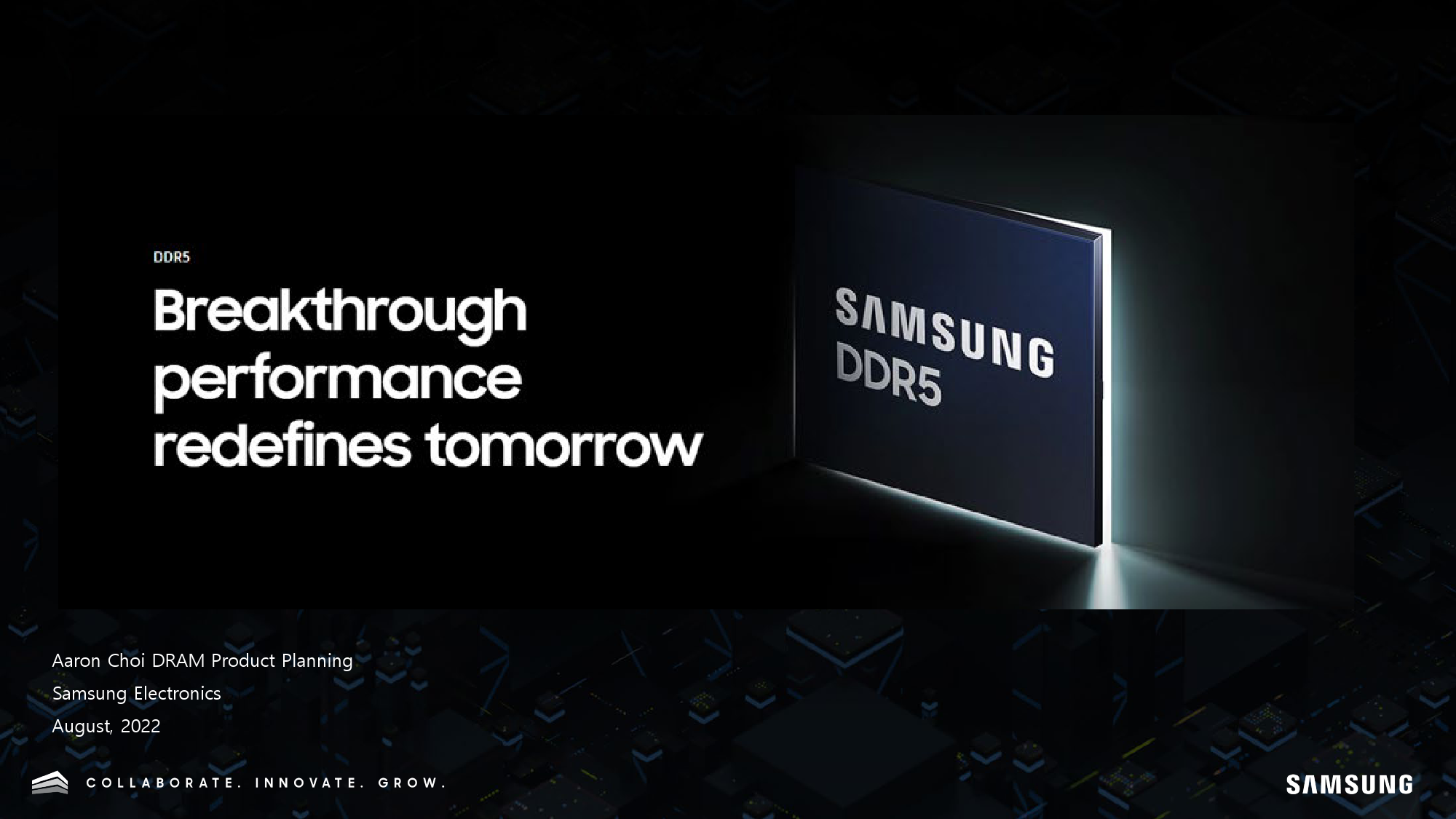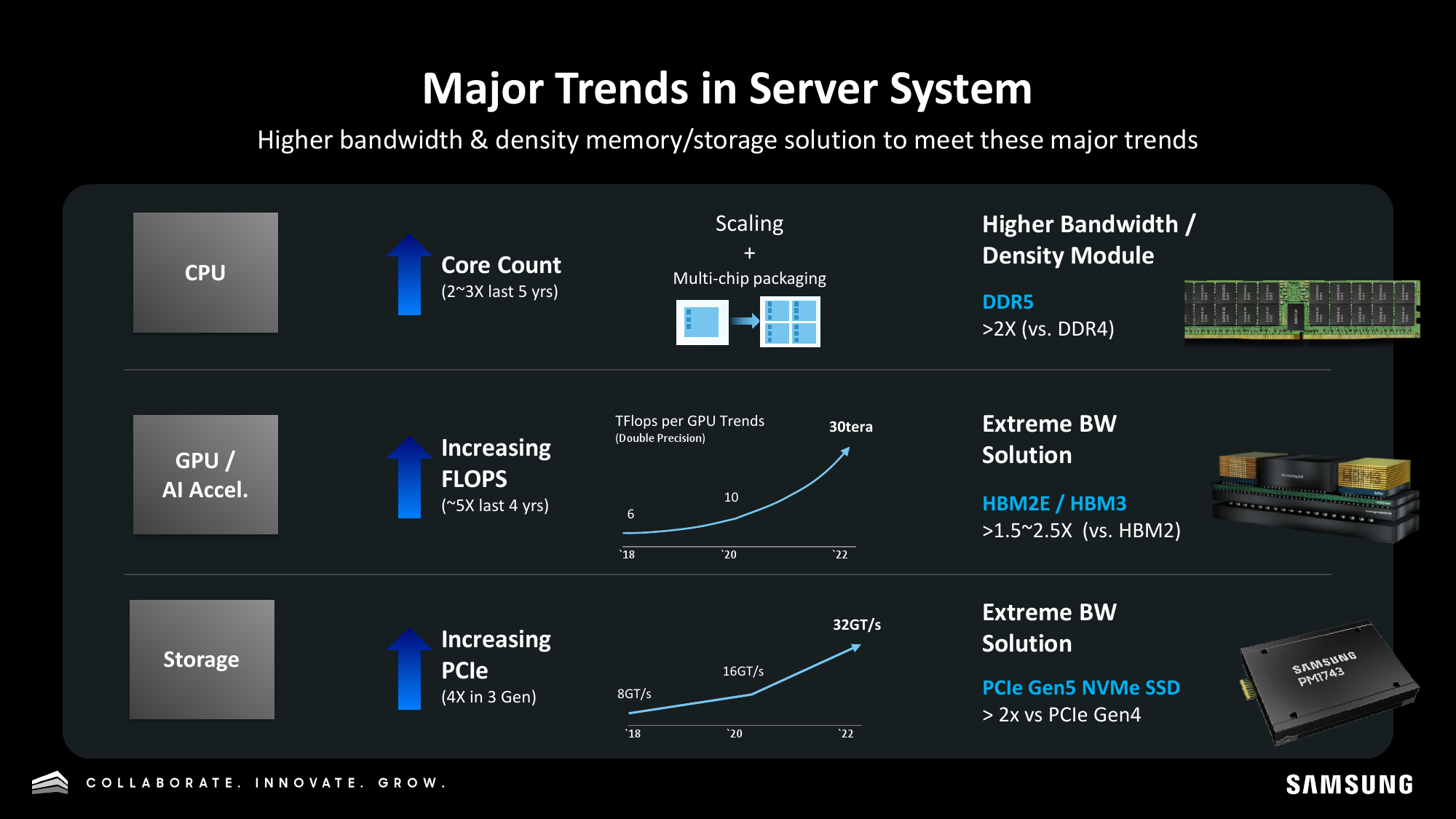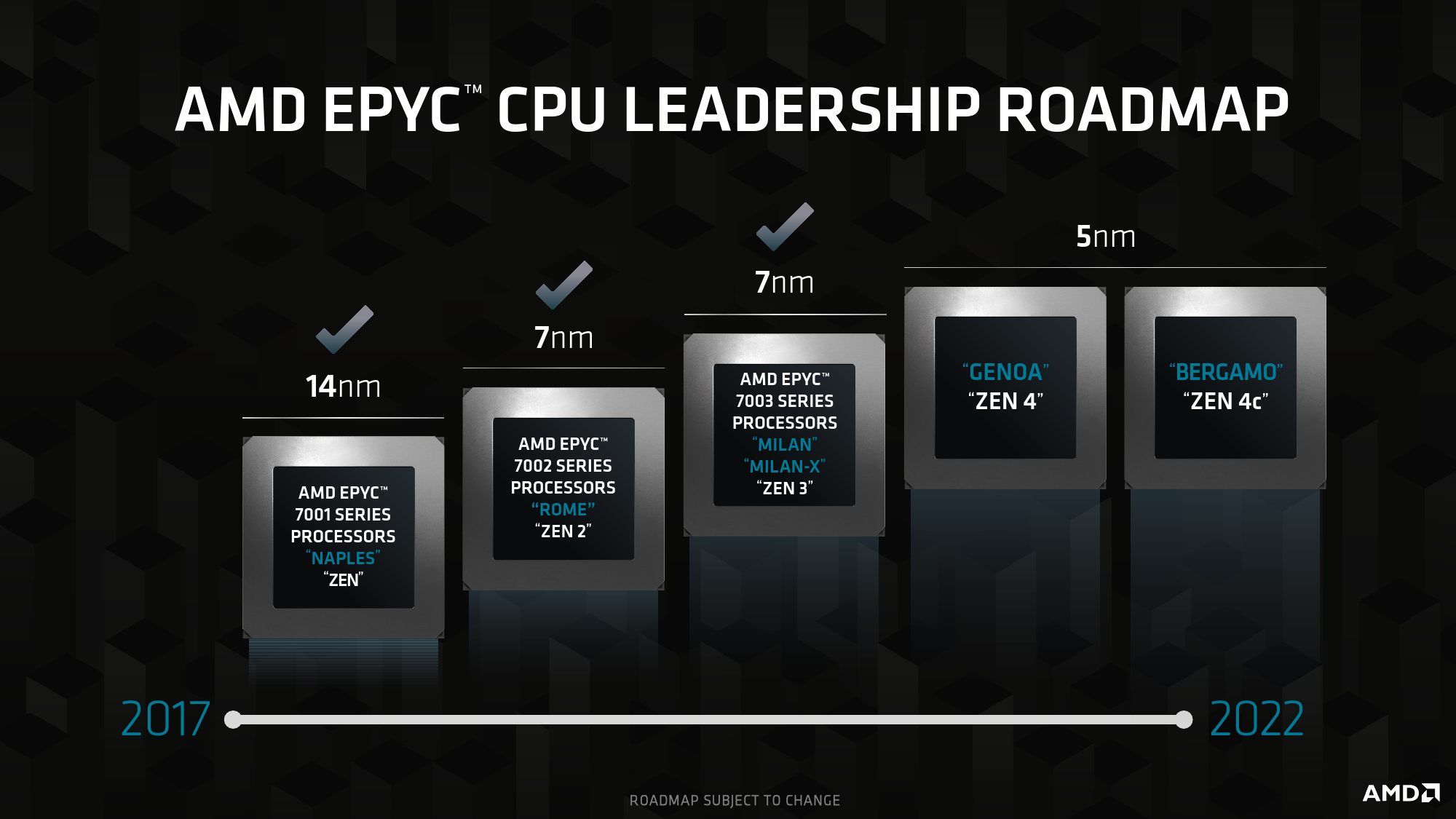Samsung: 1TB DDR5 RAM in 2024, DDR5-7200 in 2025
Samsung plans to introduce 32Gb DDR5 memory chips in early 2023 and 1TB memory modules in 2024.
To support the launch of next-generation server platforms from AMD and Intel, Samsung plans to introduce a lineup of all-new DDR5 server memory modules topped by the industry's first 512GB RDIMM/LRDIMM and based on 16Gb and 24Gb DDR5 devices. The next step in Samsung's DDR5 innovation — a 32Gb IC — will come in early 2023 and enable the company to build a 1TB memory module in late 2023 or early 2024. Meanwhile, in two years, Samsung intends to release ICs with a 7200 MT/s data transfer rate.
1TB DDR5 RDIMMs in 2024, 2TB Modules on Horizon
JEDEC's DDR5 specification presents enormous benefits for server platforms. In addition to enhanced performance scalability, they introduce new ways to increase per-chip and per-module capacities along with enhanced reliability and yield-improving techniques. Furthermore, the spec allows to build up to 64Gb monolithic DDR5 memory devices and to stack up to 16 DDR5 ICs into a chip (up to 16 ICs whose capacity is lower than 64Gb). Therefore, the emergence of 32Gb DDR5 ICs should not come as a surprise.
"32Gb DDR5 [IC] is now under development on a new [under-14nm] process node and is scheduled to be introduced early next year," said Aaron Choi, staff engineer at Samsung's DRAM planning department, at AMD's and Samsung webinar (see Samsung's presentation in a gallery below). "32Gb-based UDIMMs will be available from the end of next year or early in 2024."
Samsung intends to formally introduce 32Gb DDR5 devices sometime early next year to celebrate the finalization of its development. These chips will ramp towards the end of 2023, when Samsung might officially unveil the first products on their base — 32GB unbuffered DIMMs for client PCs. Later, the company will reveal its 1TB DDR5 memory modules that will use 32 8-Hi 32GB stacks and will be aimed at server platforms arriving in the 2024 – 2025 timeframe.
For now, DRAM makers like Samsung use 8-Hi stacks with up to eight memory devices, but several years later, they will move to more enormous stacks. For example, squeezing 16 32Gb DRAM ICs or eight 64Gb DRAM ICs into a stack will enable Samsung to build 2TB server-grade DDR5 modules and allow machines with tens of terabytes of memory per socket (e.g., a 12-channel memory subsystem supporting two DIMMs per channel might get up to 48TB of memory).
DDR5-7200 in 2025
Once yields of Samsung's 32Gb DDR5 memory devices get to levels comparable to those of 16Gb ICs, these chips will allow the building of very decently priced single-sided 32GB DIMMs, enabling desktop enthusiasts to equip their systems with 128GB of memory without breaking the bank.
But while capacity matters, high speeds are also important for enthusiasts, so Samsung is working hard to improve the performance of DDR5 devices. The company is about to introduce ICs officially rated at 5200 MT/s – 5600 MT/s and aimed at the upcoming client PC platforms. We expect these chips to be used by module houses like Corsair and G.Skill to build modules rated for 6800 MT/s – 7000 MT/s and beyond, but those will require increased voltages.
Get Tom's Hardware's best news and in-depth reviews, straight to your inbox.
Samsung envisions DDR5 chips capable of a 7200 MT/s data transfer rate at JEDEC-standard 1.1 Volts only in 2025. DDR5-7200 is a speed bin that Samsung has been talking about for some time, but without disclosing when it expects to produce appropriate devices. At the webinar, the company finally demonstrated a slide that attributes 'DDR5-7200+' to 2025. So expect memory module experts to hit speeds of 10,000+ MT/s (and higher) with such ICs.
Samsung's DDR5 Server Lineup Ready for Next-Generation Server Platforms.
Samsung and its industry peers have been talking about their server-grade DDR5 memory modules for quite some time now. Still, since there were no server platforms to support the new type of memory, those announcements were more about promised advantages of DDR5 memory (or bragging rights for DRAM companies, if you wish) than practical use cases. But now that AMD's and Intel's next-generation server platforms are approaching, these modules will finally be used.
Samsung formally introduced its 512GB DDR5 registered DIMM (RDIMM) memory module in mid-2021 and had started sampling the product even before that. That module uses 32 16GB stacks based on eight 16Gb DRAM devices and represents a pinnacle for today's DRAM industry. These modules will be available in time for next-generation AMD EPYC 'Genoa' and Intel Xeon Scalable 'Sapphire Rapids' server platforms late in 2022 or early 2023.
But not everyone needs 512GB memory modules, even for servers, so Samsung introduced 24Gb DDR5 ICs last July to support modules with capacities like 24GB, 48GB, 96GB, and potentially higher. For now, Samsung does not disclose plans to make 384GB and 768GB based on 24Gb devices. Still, its lineup of DDR5 modules for this year includes everything from 16GB to 512GB, which is good enough to address next-generation AMD EPYC 'Genoa' and Intel Xeon Scalable 'Sapphire Rapids' platforms in the foreseeable future.
"Last year, Samsung introduced 14nm DDR5 DRAMs, and they are now ramping up," said Choi. "14nm allows to make another bigger [DRAM] die, which is 24Gb, and it is almost ready to launch along with AMD's server milestones. […] This year Samsung will provide multiple lineups [based on] 24Gb dies."
While a 24GB, 48GB, or 96GB module capacity may not sound as impressive as a 512GB capacity, these memory sticks may be helpful for next-generation servers based on AMD's EPYC 'Genoa' and 'Bergamo' processors. Since AMD's next-generation server platform supports 12 memory channels, the modules will enable machines with 288MB, 576GB, or 1152GB of DDR5 memory per socket, which is very impressive. Meanwhile, since 24GB, 48GB, and 96GB modules do not need such sophisticated chip-level packaging as Samsung's 512GB RDIMM (which uses 8-Hi 3DS stacks), they may provide an impressive combination of capacity, performance, and price.
Summary
Samsung is ready with a lineup of server-grade DDR5 memory modules based on its monolithic 16Gb and 24Gb DRAM ICs. Those memory sticks will feature capacities between 16GB and 512GB and will support speed bins supported by AMD's Genoa/Bergamo as well as Intel's Sapphire Rapids platforms.
Samsung's next step will be introducing a 32Gb monolithic DDR5 die in early 2023 and bringing it to market by late 2023 or early 2024. These chips will enable the company to build 1TB DDR5 memory modules for future server platforms and inexpensive 32GB UDIMMs for client PCs.
As for speeds, Samsung is looking forward to launching DDR5-7200+ at 1.1V ICs in circa 2025, which will allow producers of memory modules for overclockers to build memory sticks rated for operation at 10,000 MT/s and beyond.


















Anton Shilov is a contributing writer at Tom’s Hardware. Over the past couple of decades, he has covered everything from CPUs and GPUs to supercomputers and from modern process technologies and latest fab tools to high-tech industry trends.
-
jeremyj_83 Right now 64GB RDIMMs are the most popular size for use in servers. Those are all manufactured using 16Gb chips. Going to 32Gb chips will allow for 128GB RDIMMs to become the most popular all while costing the same as the current 64GB RDIMMs.Reply -
TJ Hooker Does anyone know why DRR5 ECC DIMMs are still nearly nonexistent (and seemingly not really being discussed either)? I mean DIMMs that have sideband ECC, in addition to the on-die ECC that all DDR5 has.Reply
Are the big memory players just waiting until DDR5 server chips (Sapphire Rapids and/or Genoa) are shipping in bulk? I would have thought you'd want the memory to be available before that happens. -
jeremyj_83 Reply
I would assume the server vendors are buying all the L/RDIMMs right now so they will have enough stock at launch. ECC UDIMMs are really only used in low end embedded servers from what I've found. Perhaps the on-die ECC will be enough.TJ Hooker said:Does anyone know why DRR5 ECC DIMMs are still nearly nonexistent (and seemingly not really being discussed either)? I mean DIMMs that have sideband ECC, I'm addition to the on-die ECC that all DDR5 has.
Are the big memory players just waiting until DDR5 server chips (Sapphire Rapids and/or Genoa) are shipping in bulk? I would have thought you'd want the memory to be available before that happens. -
spongiemaster Reply
Sapphire Rapids has been available for a while for some of Intel's major customers. As Intel said, the delay for SR is for fully functional CPU's. Not all their customers need that, and are fine using what is working. There's no reason for memory makers to sell DDR5 ECC DIMMS to retail when there are no "DIY" platforms for sale that can use it. They're selling what they produce directly to the companies that need it.TJ Hooker said:Does anyone know why DRR5 ECC DIMMs are still nearly nonexistent (and seemingly not really being discussed either)? I mean DIMMs that have sideband ECC, I'm addition to the on-die ECC that all DDR5 has.
Are the big memory players just waiting until DDR5 server chips (Sapphire Rapids and/or Genoa) are shipping in bulk? I would have thought you'd want the memory to be available before that happens. -
TJ Hooker Reply
Hmm, I was under the impression that the majority of L/RDIMMs were also ECC, such that most servers used ECC. Don't really have a source for that though, I could be mistaken.jeremyj_83 said:I would assume the server vendors are buying all the L/RDIMMs right now so they will have enough stock at launch. ECC UDIMMs are really only used in low end embedded servers from what I've found. Perhaps the on-die ECC will be enough. -
TJ Hooker Reply
Do you have a source for SPR already being widely available? There was a bit about them planning to start shipping some chips for the Aurora supercomputer near the end of last year, but nothing but reports of delays since. Even Intel's own Xeon page makes makes no reference to 4th gen (SPR) processors.spongiemaster said:Sapphire Rapids has been available for a while for some of Intel's major customers. As Intel said, the delay for SR is for fully functional CPU's. Not all their customers need that, and are fine using what is working. There's no reason for memory makers to sell DDR5 ECC DIMMS to retail when there are no "DIY" platforms for sale that can use it. They're selling what they produce directly to the companies that need it.
https://www.intel.com/content/www/us/en/products/details/processors/xeon/scalable.html
And technically all alder lake chips support ECC DDR5. You just need a W680 motherboard (which admittedly seem pretty rare themselves, at least in consumer channels). -
jeremyj_83 Reply
I've never seen an L/RDIMM that wasn't also ECC. Granted I'm sure they were a thing a some point in time. We just don't say I need an ECC RDIMM since the RDIMM already has ECC.TJ Hooker said:Hmm, I was under the impression that the majority of L/RDIMMs were also ECC, such that most servers used ECC. Don't really have a source for that though, I could be mistaken. -
Krotow 1TB DIMMs... I already imagine planned obsolence geniuses catching the idea of next bloatware OS cycle.Reply -
bit_user Reply
I noticed the same thing. Once Supermicro's W680 boards started shipping, I started pricing an upgrade for my 10-year-old workstation. This was the first stumbling block I hit.TJ Hooker said:Does anyone know why DRR5 ECC DIMMs are still nearly nonexistent (and seemingly not really being discussed either)?
Supermicro listed one SKU of ECC DDR5 in its QVL, but you couldn't find it for sale: https://store.supermicro.com/32gb-ddr4-2666-mem-dr432l-sl01-eu26.htmlNewegg had nothing. No DDR5 in server memory, and no ECC DDR5 in desktop memory.
Crucial's website listed a 1R and a 2R module, but they didn't offer it for purchase on their website, nor could I find it anywhere else. See: https://www.crucial.com/memory/server-ddr5/mtc20c2085s1ec48ba1rKingston had no ECC DDR5. -
bit_user Reply
No. The on-die ECC is low-density and only used to paper over DDR5's higher intrinsic error rate due to smaller cell sizes, longer refresh intervals, and maybe lower-voltage.jeremyj_83 said:Perhaps the on-die ECC will be enough.
ECC DDR5 DIMMs exist because there's still a need for them. And that's in spite of the fact that they now have to be 80 bits, due to bifurcation of DDR5 DIMMs into 2x 32-bit subchannels.
